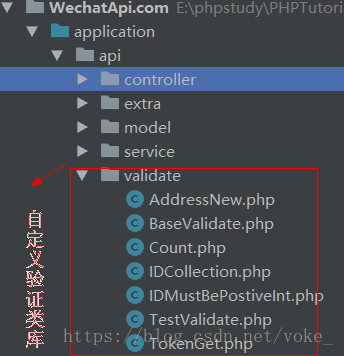一、要学习什么是 RESTful API 首先我们得明白什么是REST?
简单来说:REST是所有Web应用都应该遵守的架构设计指导原则。 英文全词Representational State Transfer,翻译是”表现层状态转化”。
面向资源 是REST最明显的特征,对于同一个资源的一组不同的操作。资源是服务器上一个可命名的抽象概念,资源是以名词为核心来组织的,首先关注的是名词。REST要求,必须通过统一的接口来对资源执行各种操作。对于每个资源只能执行一组有限的操作。(7个HTTP方法:GET/POST/PUT/DELETE/PATCH/HEAD/OPTIONS)。
简单来说就是将服务器的数据看做是资源,而RESTFUL API 就是给外部使用改变资源的一种操作方法,其中符合REST架构设置是RESTFUL API 最大的特点。其中比较典型的就是HTTP协议。
关于rest 的思想,有兴趣的同学可以参考阅读以下文章
理解本身的REST架构风格
http://www.infoq.com/cn/articles/understanding-restful-style/
理解RESTful架构
http://www.ruanyifeng.com/blog/2011/09/restful.html
Restful API设计指南
http://www.ruanyifeng.com/blog/2014/05/restful_api.html
1. 设置API Route
在TP5 中通过route.php 即可进行路由的操作,出于安全和代码迭代考虑,应注意以下点:
- 添加API 版本目录
- 指定路由访问方式 get/post
- 接口参数过滤
- API 路由接口分组
示例代码 :
//Route::rule('路由表达式', '路由地址', '请求类型', '路由参数(数组)', '变量规则(数组)'); Route::get('api/:version/Theme/:id', 'api/:version.Theme/getComplexOne',[],['id'=>'d+'] );

2.编写控制器
示例代码:
/* * 获取product * @url /theme/:id */ public function getComplexOne($id){ //调用自定义验证 (new IDMustBePostiveInt())->goCheck();//着重点 //调用模型操作方法 $theme = ThemeModel::getThemeWithProducts($id); if (!$theme){ //抛出自定义异常 throw new ThemeException();//着重点 } return $theme; }
通过MVC的架构和基于TP5提供 Validate 和 Exception 编写的 自定义验证 和 错误反馈,只需要通过寥寥几行代码,就可以完成控制器逻辑的编写,这无论对工作量来说,还是以后调优以及代码的可阅读性,都是大大的提高,下面着重说一下,自定义验证 和 错误反馈
3.编写自定义验证类 Validate
目录结构:

示例代码:
#IDMustBePostiveInt.php 编写自定义验证器,如这个验证器为ID必须是正整数,在任何需要ID验证时就都可以使用。
namespace appapivalidate; class IDMustBePostiveInt extends BaseValidate { protected $rule = [ 'id' => 'require|isPositiveInteger', ]; protected $message = [ 'id' => 'id必须是正整数' ]; }
#BaseValidate.php 编写自定义验证器,可以扩展TP5验证库,主要存放公用的验证方法,方便调用。
namespace appapivalidate; use thinkValidate; class BaseValidate extends Validate { //进行参数校验 public function goCheck() { // 获取http参数 //参数校验 $request = Request::instance(); $params = $request->param(); $result = $this->batch()->check($params); if (!$result) { $e = new ParameterException([ 'msg' => $this->error, /*
'code'=> 400, 'errorCode' => 1002
*/ ]); throw $e; } else { return true; } } //判断是否是正整数 protected function isPositiveInteger($value, $rule = '', $data = '', $field = '') { if (is_numeric($value) && is_int($value + 0) && ($value + 0) > 0) { return true; } else { return false; } } }
在日常工作中,通过会使用到参数验证,这一点在API开发中尤为重要,可以大大提高接口的安全性,但是往往TP5自带的Validate 验证方法是不够的,通过编写验证器扩展,可以圆满的补充这一点,而且也大大提高了代码的复用性,减少了工作量。
4.编写自定义错误类 Exception
文件结构:

示例代码:
#ThemeException.php 自定义错误类,可指定返回的错误信息
namespace applibexception; class ThemeException extends BaseException { // HTTP 状态码 400,200 public $code = 400; // 错误信息 public $msg = '请求的主题不存在'; //自定义错误码 public $errorCode = 30000; }
#BaseException.php 存放默认反馈信息,通过动态修改其中的默认信息,达到动态反馈的效果。
namespace applibexception; use thinkException; class BaseException extends Exception { // HTTP 状态码 400,200 public $code = 400; // 错误信息 public $msg = '参数错误'; //自定义错误码 public $errorCode = 10000; public function __construct($params = []) { if (!is_array($params)) { return; // throw new Exception('参数必须是数组'); } if (array_key_exists('code', $params)) { $this->code = $params['code']; } if (array_key_exists('msg', $params)) { $this->msg = $params['msg']; } if (array_key_exists('errorCode', $params)) { $this->errorCode = $params['errorCode']; } } }
在API开发中,接口的错误反馈尤为重要,可以为产品提供更准确的信息,通常与之相对应的还有一张API反馈信息表,通过查询该表,前端人员可以快速有效的找准错误。而对服务器本身的错误而言,通常是不需要反馈给客户端的,通过编写自定义反馈类,也可以做到这一点。
5.编写模型及关联
示例代码:
#Theme.php 作用:编写关联模型和数据库逻辑操作,指定需要查询的字段,等等。
namespace appapimodel; class Theme extends BaseModel { //关联模型 public function topicImg(){ return $this->belongsTo('Image','topic_img_id','id'); } public function headImg() { return $this->belongsTo('Image','head_img_id','id'); } public function products(){ return $this->belongsToMany('product','theme_product','product_id','theme_id'); } public static function getThemeWithProducts($id){ //使用关联模型查询 $theme = self::with('products,topicImg,headImg')->find($id); return $theme; } }
#BaseModel.php 作用:存放公用的模型修改方法,在这里为imgUrl的前缀修改。
namespace appapimodel; use thinkModel; class BaseModel extends Model { //读取更改img模型的url值--读取器 protected function prefixImgUrl($value,$data){ $finalUrl = $value; if ($data['from'] == 1) { $finalUrl = config('setting.img_prefix').$value; } return $finalUrl; } }
#Image.php 指定对ImageUrl前缀。
namespace appapimodel; class Image extends BaseModel { //隐藏不需要返回的字段 // protected $hidden = ['delete_time','id','update_time','from']; protected $visible = ['url']; //读取更改img模型的url值--读取器 public function getUrlAttr($value,$data){ return $this->prefixImgUrl($value,$data); } }
至此,一个结构优美,代码复用性高的API开发大框就出现规模了,篇幅有限,有许多小的知识点如SerService层,Token 编写,缓存等就不在一一赘述。